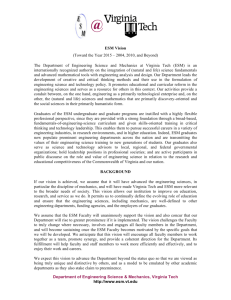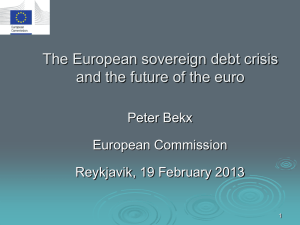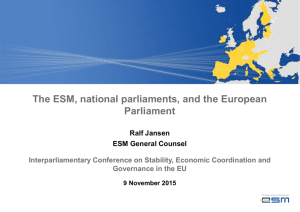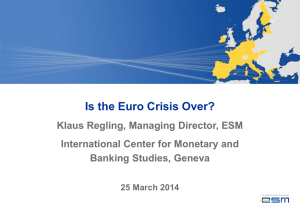4 Lectures on the €uropean crisis
advertisement
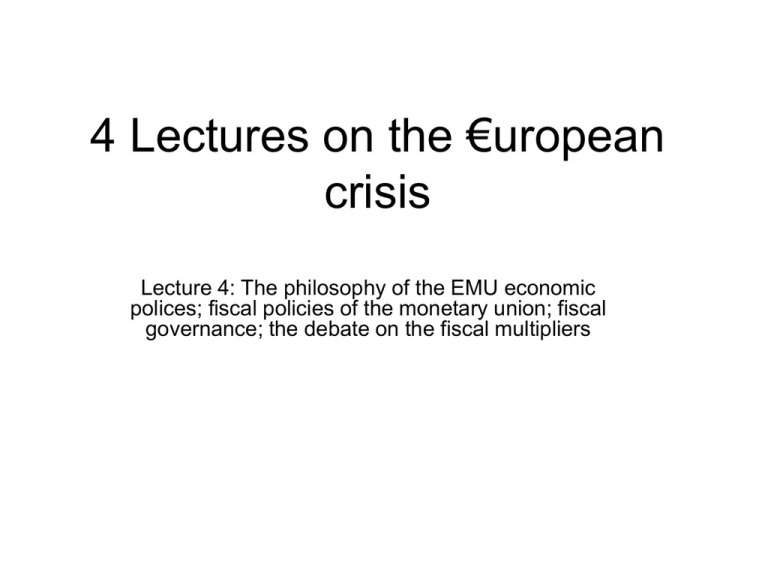
4 Lectures on the €uropean crisis Lecture 4: The philosophy of the EMU economic polices; fiscal policies of the monetary union; fiscal governance; the debate on the fiscal multipliers The “philosophy” of the EMU economic policies • Independent CB monetary policy is ineffective in the long run; price stability is the predominant target • Budget deficit crowds out private investment. So balanced budget rules Maastricht Treaty and Stability and Growth Pact reinforced by most recent measures (six and two packs; fiscal compact) • Full employment pursued at national level through market and (mainly) labour market flexibility. • A full anti-Keynesian program; no ex-ante coordination of budget and monetary policies. • Otmar Issing no need for ex ante coordination. If countries follow the rules there will be an ex post coordination by he market. Alternative view • Monetary policy is effective; of course, expansionary policies raise inflation, but a “natural unemployment rate” defined at a zero (or very low) inflation rate is a fiction useful to keep wages under control. Income policy should be used to keep inflation under control. • Fiscal policy does not crowd out private investment which are, in general, not at full employment level • Coordination between fiscal and monetary policy at an international level is necessary in order to permit fiscal expansions, when necessary, at low interest rates. • Full employment is an international question, not a national one! International coordination is necessary. • There is not a potential output at which, with price and wages flexibility, the economy tends to; potential output depends on long term aggregate demand and if AD is depressed, productive capacity is lost. The European economic governance http://europa.eu/rapid/press-release_MEMO-13979_en.htm • Crisis prevention: Fiscal policy regulated by the GSP (Amsterdam 1997) and by a baroque number of new regulations approved in the last years. • The Stability and Growth Pact was established at the same time as the single currency in order to ensure sound public finances. However, the way it was enforced before the crisis did not prevent the emergence of serious fiscal imbalances in some Member States. • It has been reformed through the Six Pack (which became law in December 2011) and the Two Pack (which entered into force in May 2013), and reinforced by the Treaty on Stability, Coordination and Governance (which entered into force in January 2013 in its 25 signatory countries). • The new rules (introduced through the Six Pack, the Two Pack and the Treaty on Stability, Coordination and Governance) are grounded in the European Semester, the EU's policy-making calendar. • Crisis management • EFSF and ESM The European economic governance: Growth and stability pact • • • • The SGP contains two arms – the preventive arm and the corrective arm. The preventive arm seeks to ensure that fiscal policy is conducted in a sustainable manner over the cycle. The corrective arm sets out the framework for countries to take corrective action in the case of an excessive deficit. The cornerstone of the preventive arm is the country-specific medium-term budgetary objective (MTO), defined in structural terms (i.e. in cyclically adjusted terms and net of one-off and other temporary measures). Member States outline their medium-term budgetary plans in stability and convergence programmes (SCP), which are submitted and assessed annually in the context of multilateral fiscal surveillance under the European Semester. The corrective arm is made operational by the Excessive Deficit Procedure (EDP), a step-by-step procedure for correcting excessive deficits that occur when one or both of the rules that the deficit must not exceed 3% of GDP and public debt must not exceed 60% of GDP (or at least diminish sufficiently towards the 60%) defined in the Treaty on the Functioning of the EU (TFEU or Treaty) are breached. Non-compliance with either the preventive or corrective arms of the Pact can lead to the imposition of sanctions for euro area countries. In the case of the corrective arm, this can involve annual fines for euro area Member States and, for all countries, possible suspension of Cohesion Fund financing until the excessive deficit is corrected. The European economic governance: the European semester • The European Semester represents a yearly cycle of EU economic policy guidance and country-specific surveillance. Each year the European Commission undertakes a detailed analysis of EU Member States' programmes of economic and structural reforms and provides them with recommendations for the next 12-18 months. • Within the European semester the European authorities intervene in the formulation of national fiscal policies (ex ante coordination) • (e.g. the Commission in November had reservations about the Italian budget ) The European semester: some relevant dates • • • • • • October: Euro area Member States submit draft budget plans for the following year to the Commission (by 15 October). If a plan is out of line with a Member State's medium-term targets, the Commission can ask it to be redrafted. November: The Commission publishes its opinions on draft budget plans. The Alert Mechanism Report (AMR) screens Member States for economic imbalances. December: Euro area Member States adopt final annual budgets, taking into account the Commission's advice and finance ministers' opinions. February/March: It is around this time that the Commission publishes in-depth reviews of Member States with potential imbalances (those identified in the AMR). April: Member States submit their Stability/Convergence Programmes (mediumterm budget plans) and their National Reform Programmes (economic plans), which should be in line with all previous EU recommendations. Eurostat publishes verified debt and deficit data from the previous year, which is important to check if Member States are meeting their fiscal targets. June/July: The European Council endorses the CSRs, and EU ministers meeting in the Council discuss them. EU finance ministers ultimately adopt them in July. Six pack • Entered into force on 13 December 2011; • Five Regulations and one Directive (that is why it is called six-pack); • Applies to 27 MS with some specific rules for euro-area Member States, especially regarding financial sanctions; • The six-pack does not only cover fiscal surveillance, but also macroeconomic surveillance under the new Macroeconomic Imbalance Procedure. • In the fiscal field, the six-pack strengthens the Stability and Growth Pact (SGP). According to the SGP Member States' budgetary balance shall converge towards the country-specific medium-term objective (MTO) - so-called preventive arm - and the general government deficit must not exceed 3% of GDP and public debt must not exceed 60% of GDP (or at least diminish sufficiently towards the 60% threshold). The six-pack reinforces both the preventive and the corrective arm of the Pact, i.e. the Excessive Deficit Procedure (EDP), which applies to Member States that have breached either the deficit or the debt criterion. Six Pack – The six-pack ensures stricter application of the fiscal rules by defining quantitatively what a "significant deviation" from the MTO or the adjustment path towards it means in the context of the preventive arm. – Moreover, the six-pack operationalizes the debt criterion, so that an EDP may also be launched on the basis of a debt ratio above 60% of GDP which would not diminish towards the Treaty reference value at a satisfactory pace (and not only on the basis of a deficit above 3% of GDP, which has been the case so far). – Financial sanctions for euro-area Member States are imposed in a gradual way, from the preventive arm to the latest stages of the EDP, and may eventually reach 0.5% of GDP. The six-pack introduces reverse qualified majority voting (RQMV) for most sanctions, therefore increasing their likelihood for euro-area Member States. (RQMV implies that a recommendation or a proposal of the Commission is considered adopted in the Council unless a qualified majority of Member States votes against it.) Treaty on Stability, Coordination and Governance (TSCG) • Entered into force on 1 January 2013. • The fiscal part of the TSCG is referred to as "Fiscal Compact". Requires contracting parties to respect/ensure convergence towards the country-specific medium-term objective (MTO), as defined in the SGP and Six Pack (e.g. convergence to 60% at the pace of 1/20 per year). • Lower limit of a structural deficit (cyclical effects and one-off measures are not taken into account) of 0.5% of GDP; (1.0% of GDP for Member States with a debt ratio significantly below 60% of GDP). • These budget rules shall be implemented in national law through provisions of "binding force and permanent character, preferably constitutional". ( this is the real novelty of the TSCG). Compliance with the rule should be monitored by independent institutions • European Court of Justice (CoJ) may impose financial sanction (0.1% of GDP) if a country does not properly implement the new budget rules in national law and fails to comply with a CoJ ruling that requires it to do so. Two Packs • Approved 13 May 2013. Reinforces the role of the Commission in the evaluation of national budgets • As part of a common budgetary timeline, euro-area Member States shall submit their draft budgetary plan for the following year to the Commission and the Eurogroup before 15 October, along with the independent macro-economic forecast on which they are based. • This builds on the Stability and Growth Pact (SGP), under which Member States present the main characteristics of their mediumterm public finance plans to the Commission and the Council in spring (in Stability or Convergence Programmes). The exercise in autumn introduced by the two-pack allows monitoring and sharing information on MS budgetary policies closer to their adoption. The Commission analyses if the draft budget is in line with the SGP and the recommendations from the European Semester (which the country has received in May/June). • If the Commission assesses that the draft budgetary plan shows serious non-compliance with the SGP, the Commission can require a revised draft budgetary plan. Macroeconomic Imbalance Procedure (MIP) (Included in the Six Pack) • • • • • The Macroeconomic Imbalance Procedure (MIP) is a surveillance mechanism that aims to identify potential risks early on, prevent the emergence of harmful macroeconomic imbalances and correct the imbalances that are already in place. The alert mechanism consists of an indicator-based scoreboard complemented by an economic reading thereof presented in an annual Alert Mechanism Report (AMR). On this basis, the Commission decides for which countries it will prepare country-specific in-depth reviews. In the preventive arm this is part of the integrated package of recommendations under the European semester. If the Commission instead considers that there are severe or excessive imbalances that may jeopardise the proper functioning of the Economic and Monetary Union, it may recommend to the Council to open an Excessive Imbalance Procedure (EIP) which falls under the corrective arm of the new procedure. In case the in-depth review points to severe or excessive imbalances in a Member State that may jeopardise the proper functioning of the Economic and Monetary Union, the Council may declare the existence of an excessive imbalance and adopt a recommendation asking the Member State to present corrective actions within a specified deadline. Scoreboard indicators: a boring and expected list with few (limited) exceptions • • • • • • • • • • • 3 year backward moving average of the current account balance as percent of GDP, with thresholds of +6% and -4% ; net international investment position as percent of GDP, with a threshold of -35%; 5 years percentage change of export market shares measured in values, with a threshold of -6%; 3 years percentage change in nominal unit labour cost, with thresholds of +9% for euroarea countries and +12% for non-euroarea countries; 3 years percentage change of the real effective exchange rates based on HICP/CPI deflators, relative to 41 other industrial countries, with thresholds of -/+5% for euroarea countries and -/+11% for non-euroarea countries; private sector debt (consolidated) in % of GDP with a threshold of 133%; private sector credit flow in % of GDP with a threshold of 15%; year-on-year changes in house prices relative to a Eurostat consumption deflator, with a threshold of 6%; general government sector debt in % of GDP with a threshold of 60%; 3-year backward moving average of unemployment rate, with a threshold of 10%; year-on-year changes in total financial sector liabilities, with a threshold of 16.5%. Limits: bad Economics and morality play • Why the asymmetry +6%/-4% CA surpluses? CA surpluses are a vice from the international economy point of view. Stop the morality play in Economics. • Why only a negative NIP is sanctioned? Huge positive NIP must as well. • Why in case of imbalances action must be taken at national level only? This is again a morality play (YOU are guilty) and bad Economics: • “In case the in-depth review points to severe or excessive imbalances in a Member State that may jeopardise the proper functioning of the Economic and Monetary Union, the Council may declare the existence of an excessive imbalance and adopt a recommendation asking the Member State to present corrective actions within a specified deadline. Then, …, the Member State is obliged to present a corrective action plan (CAP) setting up a roadmap to implement corrective policy actions. The CAP should be a detailed plan for corrective actions with specific policy measures and implementation timetable. As regards the content of the CAP it is clear that the policy response to macroeconomic imbalances has to be tailored to the circumstances of the Member State concerned and where needed will cover the main policy areas, including fiscal and wage policies, labour markets, product and services markets and the financial sector. Moreover, efficiency and credibility derive from consistent approaches across policy strands.” Macroeconomic Imbalance Procedure for Germany: much ado about nothing • Daniel Gros argues that the 13 November announcement of the European Commission that Germany is running an excessive current account surplus appears to be much ado about little. All the Commission can, and will, do is to start an ‘in depth analysis’. This might lead to strong political reactions and an enormous echo in the media. But nothing of concrete substance is likely to follow. (http://www.ceps.eu/book/macroeconomic-imbalance-procedure-and-germany-whensurplus-%E2%80%9Cimbalance%E2%80%9D) The mysterious Golden rule: Let us (Letta’s) have a dream • In principles “well behaved” countries, those not under a EDP, will be able to exclude the following year some public investment from the deficit. Spain and France decided not to well behave, and are in principle subject to the EDP. But they grew (or better, they declined less) than Italy. In spite of huge austerity Oli Rehn (I refrain from defining its intelligence) said no. We do not trust Italy’s efforts. They asked more austerity! They are right not to trust the Italian government. The question is that all the European policy framework is mad. European acronymia: EFSF and ESM • The European Financial Stability Facility (EFSF) was created by the euro area Member States following the decisions taken on 9 May 2010 within the framework of the Ecofin Council. The EFSF’s mandate is to safeguard financial stability in Europe by providing financial assistance to euro area Member States within the framework of a macro-economic adjustment programme. • To fulfill its mission, EFSF issues bonds or other debt instruments on the capital markets. The proceeds of these issues are then lent to countries under a programme. The EFSF may also intervene in the primary and secondary bond markets, act on the basis of a precautionary programme and finance recapitalisations of financial institutions through loans to governments. • EFSF was created as a temporary rescue mechanism. In October 2010, it was decided to create a permanent rescue mechanism, the European Stability Mechanism (ESM). The ESM entered into force on 8 October 2012. • From this date onwards, the ESM will be the main instrument to finance new programmes. In parallel to the ESM, the EFSF will continue with the ongoing programmes for Greece, Portugal and Ireland. EFSF • • • • • • The Facility act after a support request is made by a euro area Member State and a country programme has been negotiated with the European Commission and the IMF and after such a programme has been accepted by the euro area finance ministers and a Memorandum of Understanding (MoU) is signed. This would only occur when the country is unable to borrow on markets at acceptable rates. any financial assistance to a country in need is linked to strict policy conditions which are set out in a Memorandum of Understanding (MoU) between the country in need and the European Commission. Following the increase of guarantee commitments to €780 billion, EFSF’s effective lending capacity is intended to be €440 billion. This is explained by the credit enhancement structure which includes an overguarantee of up to 165% On 28 November 2010, the ECOFIN Ministers concurred with the European Commission and the ECB that providing a loan to Ireland was warranted to safeguard the financial stability in the euro area and the EU as a whole. The total lending programme for Ireland is €85 billion. Following the formal request for financial assistance made by the Portuguese authorities on 7 April 2011, the Eurogroup and ECOFIN Ministers agreed to grant financial assistance on 17 May. The financial package of the programme will cover financing needs up to €78 billion. At the euro zone summit held on 26 October 2011, euro zone Heads of State or Government agreed to a second financial assistance programme for Greece. The details of this programme were agreed by the Eurogroup on 21 February 2012. As part of the second bailout for Greece, the loan is shifted to the EFSF, amounting to €164 billion ESM • • • • • • • • • • The European Stability Mechanism is the permanent crisis resolution mechanism for the countries of the euro area. The ESM issues debt instruments in order to finance loans and other forms of financial assistance to euro area Members States. The decision leading to the creation of the ESM was taken by the European Council in December 2010. The euro area Member States signed an intergovernmental treaty establishing the ESM on 2 February 2012. The ESM was inaugurated on 8 October 2012. For this purpose, the ESM is entitled to raise funds by issuing financial instruments or by entering into financial or other agreements with ESM Members, financial institutions or other third parties. All financial assistance to Member States is linked to appropriate conditionality. The ESM may provide stability support by: -providing loans to countries in financial difficulties, purchasing bonds of an ESM Member State in primary and secondary debt markets, providing precautionary financial assistance in the form of a credit line, financing recapitalisations of financial institutions through loans to governments including in non-programme countries. The ESM’s maximum lending capacity is €500 billion. During the Eurogroup meeting held on 30 March 2012, it was decided that the EFSF would continue to fund the existing Facility Agreements for Portugal, Ireland and Greece. ESM • • • • • Stability support loans within a macro-economic adjustment programme. The objective is to assist ESM Members that have significant financing needs but have to a large extent lost access to market financing, whether because they cannot find lenders or because lenders will provide financing only at excessive prices that would adversely impact the sustainability of public finances. Precautionary financial assistance The objective of ESM precautionary financial assistance in the form of credit lines is to support sound policies and prevent crisis situations by allowing ESM Members to secure ESM assistance before they face major difficulties raising funds in the capital markets. Precautionary financial assistance aims at helping ESM Members whose economic conditions are still sound to maintain continuous access to market financing by reinforcing the credibility of their macroeconomic performance while ensuring an adequate safetynet. Primary Market support facility The ESM may engage in primary market purchases of bonds or other debt securities issued by ESM Members to allow them to maintain or restore their relationship with the dealer/investment community and therefore reduce the risk of a failed auction. It would also serve to increase efficiency of ESM lending. Conditions would be those of the macroeconomic adjustment programme or precautionary programme. As announced by ECB President Mario Draghi on 6 September 2012, Outright Monetary Transactions, i.e. is the purchase of euro area sovereign bonds on the secondary market by the ECB, will be considered for future cases of EFSF/ESM macroeoconomic adjustment programmes or precautionary programmes, provided that they include the possibility of EFSF/ESM primary market purchases. ESM • • • • Secondary Market Support Facility The Secondary Market Support Facility aims to support the good functioning of the government debt markets of ESM Members in exceptional circumstances where the lack of market liquidity threatens financial stability, with a risk of pushing sovereign interest rates towards unsustainable levels and creating refinancing problems for the banking system of the ESM Member concerned. An ESM secondary market intervention is intended to enable market-making that would ensure some debt market liquidity and incentivise investors to further participate in the financing of ESM Members. Bank recapitalisations The aim of a loan for recapitalising financial institutions is to preserve financial stability of the euro area as a whole and of its Member States by addressing those specific cases in which the roots of a crisis situation are primarily located in the financial sector and not directly related to fiscal or structural policies. Will the ESM make loans directly to financial institutions? Currently, the ESM may only lend to euro area Member States. However, at the euro area summit on 29 June 2012, it was proposed that once an effective supervisory mechanism is established for banks in the euro area, involving the ECB, following a regular decision the ESM could have the possibility to recapitalise banks directly. ESM • On 25 June 2012, the Spanish government made an official request for financial assistance for its banking system to the Eurogroup for a loan of up to €100 billion.The results of the diagnostic exercise, commissioned by the Spanish authorities to external evaluators, indicated that the additional capitalisation needs of the Spanish banking sector as a whole could be estimated to be in a range of €51-62 billion. Including an additional safety margin, these capital needs would remain within the envelope approved by the Eurogroup of up to €100 billion in total. • The programme will address the exceptional financial, budgetary and structural challenges that Cyprus is facing. The total amount of financial assistance, agreed by the Eurogroup, is up to €10 billion. Out of this amount, the ESM will provide approximately €9 billion, and the IMF will contribute around €1 billion. Comments • Funds collected by the ESM are guaranteed by the same troubled states, a vicious circle. Only the ECB can guarantee the ESM. • The ESM plays the role of the ECB without the printing press! • Proposals that the ESM functions as a bank, that is uses its capital as leverage to borrow from the ECB (this is a way to circumvent the prohibition to the ECB to buy sovereign debt). • Prohibition to the ESM to lend directly to troubled banks • Small size in the case of a default risk of a major country. Indeed the ECB is the only institution that can avoid big defaults. It has always been so, it cannot be otherwise; CBs have been invented with that purpose! The debate on the fiscal multiplier Y 1 [Ca I G E ( )] 1 c[1 t ] m( ) • When G falls or t rises, Y will fall. The question is the dimension of the fall. Strong debate over 2011-13 on the size of the multipliers, that is on the effects of fiscal austerity (or of the opposite fiscal expansion). • A multiplier of 1.5, for instance, means that $1 in governmentspending cuts reduces GDP by $1.50; a multiplier of 0.5 means a $1 cut in spending only reduces GDP by 50 cents. • Keynesians the multipliers are large • supporters of expansionary fiscal retrenchment or of Ricardo-Barro effect multipliers are low The conservatives’ viewpoint • Ricardo-Barro effect: if t falls, Y will remain constant since people expect more future taxes, so they will save they save all the extraincome they receive via tax-reductions. Likewise, in case of fiscal austerity if t rises, people will save less expecting to pay less taxes in the future, so non effects on Y. • On Ricardo-Barro during a crisis people consume less than they like to; so if they get extra-income (through lower taxes or by getting a subsidy or a job), they will spend more. Conversely if during a crisis taxes are increased, people will might save less but just because they feel impoverished! Or, if they can, they save the same being afraid of the future. • Expansionary fiscal retrenchment (Alberto Alesina and Bocconi boys) austerity and leads to higher credibility of long-run budget sustainability and to lower interest rates that help the adjustment in a virtuos circle In Europe conservatives have lost in theory but (unfortunately) prevail in practice (they have not won in Germany) • Further and further empirical estimates of the fiscal multipliers have shown that they are larger than 1, often much larger; they are large in depressions, when capacity and labour are under-utilised; they are larger if monetary policy is cooperative keeping interest payments low. This is from Krugman References • • • • • • http://ec.europa.eu/economy_finance/articles/governance/2012-0314_six_pack_en.htm http://ec.europa.eu/economy_finance/economic_governance/ http://ec.europa.eu/economy_finance/economic_governance/macroeconomi c_imbalance_procedure/index_en.htm http://www.efsf.europa.eu/attachments/EFSF%20FAQ%2001072013.pdf http://www.esm.europa.eu/pdf/FAQ%20ESM%2022102013.pdf Gerhard Illing*, Sebastian Watzka, Fiscal Multipliers and Their Relevance in a Currency Union – A Survey, German Economic Review, 2013.
